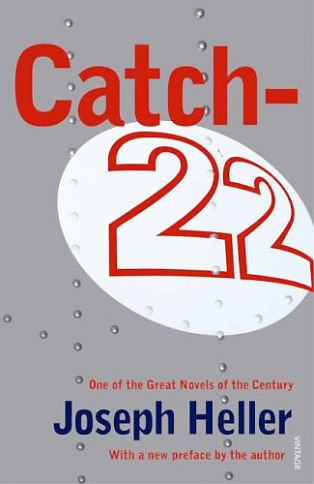Catch-22 by Joseph Heller
I’ve been waiting for the right time to blog about this book, and what better time than 22 minutes past midnight? For those of you who don’t know it, Catch-22 is a satirical work which recounts the story of Captain Yossarian and other members of a U.S. air force squadron based in Pianosa during the Second World War. Although it’s set in World War II, Catch-22 is actually more of a criticism of the ensuing Cold War, which is revealed through Heller’s use of anachronisms within the novel, for example the slogan “What’s good for M & M enterprises is good for the country” alludes to Charles Erwin Wilson’s statement to the Senate “What’s good for General Motors is good for the country”. The novel lays into the ridiculous causes of twentieth century political conflict and the chaos caused by bureaucracy, as well as the greed of capitalism that is masked behind an idea that everybody has an opportunity and everybody gets a share.
The novel does take a while to get into, I’ll admit. The circular logic Heller uses and the repetitive conversations the characters have, particularly towards the start of the novel, mean that much concentration is required and it doesn’t make for a light read. Often the reader is given an impression of ridiculousness- but of course, this is the point Heller is trying to make; millions of lives were lost in the twentieth century due to the ridiculous decisions of men in positions of power. The advice I would give you here is perservere– personally, once I got past the chapter on Major Major I found that the novel was much more engaging, and more of a plot started to develop. Another of the novel’s features that make it often difficult to comprehend is the apparent lack of structure- although when you pay attention you realise that the novel actually is structured, the lack of division of the novel into ‘parts’ means that it often seems as though the chapters aren’t arranged into any clear sequence, but in fact they are and as the novel continues the plot becomes more apparent. The second half is definitely more enjoyable than the first half which, though interesting and containing much humorous satire, is often difficult to follow. Whilst at first I was thinking what a relief it would be to finish Catch-22, by the end of the novel I was sad to finish it.
One of my favourite things about Catch-22 is that it is not a novel which glorifies bravery and dying for one’s country. Were World War III to break out, the chances are that each and every one of us would be asked to lay down our lives for our country, were it needed, without taking into consideration that this goes against one of the most basic human instincts; the need to survive. Heller does not portray Yossarian’s overwhelming desire to live as cowardly or shameful, but rather as natural- who wouldn’t want to save their own life, even during a war? I also found Yossarian’s viewpoint on the enemy’s attempts on his life amusing; he tells Clevinger that he fears they are trying to kill him, because they are shooting at him, and when Clevinger replies “they’re shooting at everybody”, Yossarian simply asks him “What difference does that make?”. Because really, what difference does it make if someone shoots at you in a battlefield or in your own front garden? Either way, they want you dead. If you kill someone in battle or in the local supermarket the end result is still the same- they’re still dead and you’re still responsible. It’s an idea that I’d never really thought of before and it has made me think more deeply about the circumstances surrounding death- if you die for your country, at the end of the day you’re still dead, so how glorious is it really?
On a slightly less morbid note, the novel really is very funny in places. The last chapter left me with a very wide smile on my face and made me laugh out loud several times. In other places the humour is more subtle, but it runs throughout. On the other hand, as the novel progresses it becomes increasingly gory- there is a horrific incident of a character being severed in half, for example. However, in what for me is the most gruesome scene in the novel there is no blood split. The scene in which Aarfy is totally unaffected by Yossarian’s all-consuming rage is absolutely horrific, as there is nothing Yossarian can do to affect this slimy, sinister man. The feeling of blinding rage and total impotence are truly horrifying, and I felt a little shaken by the scene; it was like something out a nightmare, and is a work of considerable skill.
In Catch-22 Heller exposes the injustice and absurdity of twenty-first century and will make you feel frustrated by the ridiculousness that arose from the bureaucracy. Catch-22 is a book which makes you question what you thought you knew about authority and patriotism, and will, eventually, absorb you and cause you to long for Yossarian’s survival almost as strongly as he himself does. I’d recommend this book to anyone who enjoys being introduced to new ideas or has an interest in twenty-first century literature. Personally I think that everyone should read it, but I know not everyone would enjoy it, in spite of its genius; I, however, most certainly did.
Have YOU read Catch-22? I’d love to know what you thought, so please leave a comment!
